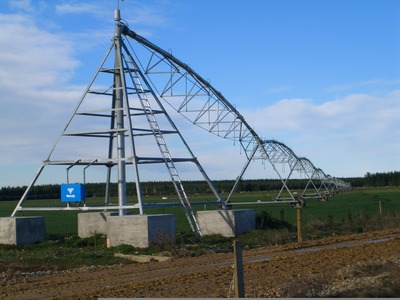New tool to assist with on-farm irrigation management
NIWA researchers are working with five Canterbury farmers to develop and trial an innovative tool that generates tailored, site-specific weather forecasts to help manage irrigation. The tool could result in significant improvements in water use efficiency and, ultimately, considerable financial savings.
The initiative forms part of the Primary Innovation project funded by the Ministry of Business, Innovation and Employment (MBIE). The project involves scientists from a number of research organisations serving the primary sector, as well as growers, farmers and foresters, and aims to convert scientific research into innovations that will add value to New Zealand’s economy.
Farmers commonly rely on irrigation to maintain productivity. They need to know when and how much water to use, and the amount of water available to them, especially in drier periods. The five farmers trialling the new management tool are members of the Waimakariri Irrigation Scheme, which draws water from the Waimakariri River.
The new tool combines measurements of on-farm rainfall and soil moisture with NIWA data on recent weather conditions in the area, and two-, six- and 15-day weather forecasts. This information is emailed to farmers every day to support decisions relating to a range of farm activities, including irrigation scheduling and stock movement.

“We are providing information to help farmers optimise their use of water and not exceed their allocation limits,” said project leader and NIWA hydrologist MS Srinivasan. “If it’s going to rain tomorrow there may be no need to irrigate today, and water can be stored or left in the river.
“We are providing forecasts that are site-specific and based upon measured rainfall and soil moisture data from the farm and from climate stations within 5 km.”
The information allows the farmers to plan water usage based on current and forecast conditions on their farm in the short and longer term. It also assists with decisions such as the need for storage ponds that hold water for use during dry periods when water available from the river is going to be limited.
The tool can also help farmers schedule fertiliser and manure applications. Nutrients can wash away in the rain to receiving waterways. If rain is forecast, farmers may delay applying fertiliser. However, if drizzle is forecast for tomorrow, farmers may consider applying urea today as the drizzle may help reduce volatile losses from the fertiliser.
With all the monitoring equipment in place on the five farms, the scientists and farmers are now finetuning and trialling the tool.
“The challenge for us is to find out what information is of most benefit to the farmers and the best methods and times to get that information to them, so they’re able to plan effectively,” said Srinivasan.
Ngai Tahu Farming is pleased to be involved in the project. General Manager Andrew Clayton said, “We think it is great to be partnering with NIWA on a system that is designed to improve outcomes for the wider environment. Our dairy farm managers at Eyrewell are now using real-time information to produce better outcomes.”
Primary Innovation leader Dr James Turner of AgResearch says the NIWA research is one of four case studies from which it is hoped to learn more about, and make improvements to, the agricultural innovation process in New Zealand.
Novel approach to desalination tech could help to ease water scarcity
UniSA researchers have overcome a limitation of desalination plants, successfully trialling a new...
Advanced method to detect harbour sewage
Macquarie University researchers have investigated the level of sewage pollution in 18 global...
Aust company secures first European order for PFAS treatment
Under the $475K contract, works will involve the design, construction and commissioning of a...








